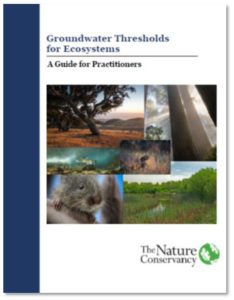 Groundwater is a key source of water for agricultural, industrial and drinking purposes. However, it is also a critical water source for many ecosystems, providing a buffer during dry periods and critical habitat for rare and endemic species. Increasing groundwater use to meet human water demands can outcompete these ecosystem water needs, causing irreversible damage to ecosystems, such as the loss of species or habitats. Groundwater management decisions seldom consider ecosystem water needs, and there is a need to quantify groundwater thresholds that can signal the levels, flows, temperature or quality of water that will not cause adverse impacts to ecosystems, in order to ensure sustainable management of the resource. To address this need, The Nature Conservancy, a partner of the Groundwater Solutions Initiative for Policy and Practice (GRIPP), has published a new report titled Groundwater Thresholds for Ecosystems: A Guide for Practitioners. This guide, targeted at water managers and conservation practitioners, presents a five-step process for establishing thresholds with varying levels of data availability, as well as three case studies from Texas, USA. Establishing groundwater thresholds can help protect ecosystems when evaluating new water development projects, developing groundwater management plans, or meeting legal requirements such as the Endangered Species Act.
Groundwater is a key source of water for agricultural, industrial and drinking purposes. However, it is also a critical water source for many ecosystems, providing a buffer during dry periods and critical habitat for rare and endemic species. Increasing groundwater use to meet human water demands can outcompete these ecosystem water needs, causing irreversible damage to ecosystems, such as the loss of species or habitats. Groundwater management decisions seldom consider ecosystem water needs, and there is a need to quantify groundwater thresholds that can signal the levels, flows, temperature or quality of water that will not cause adverse impacts to ecosystems, in order to ensure sustainable management of the resource. To address this need, The Nature Conservancy, a partner of the Groundwater Solutions Initiative for Policy and Practice (GRIPP), has published a new report titled Groundwater Thresholds for Ecosystems: A Guide for Practitioners. This guide, targeted at water managers and conservation practitioners, presents a five-step process for establishing thresholds with varying levels of data availability, as well as three case studies from Texas, USA. Establishing groundwater thresholds can help protect ecosystems when evaluating new water development projects, developing groundwater management plans, or meeting legal requirements such as the Endangered Species Act.










































